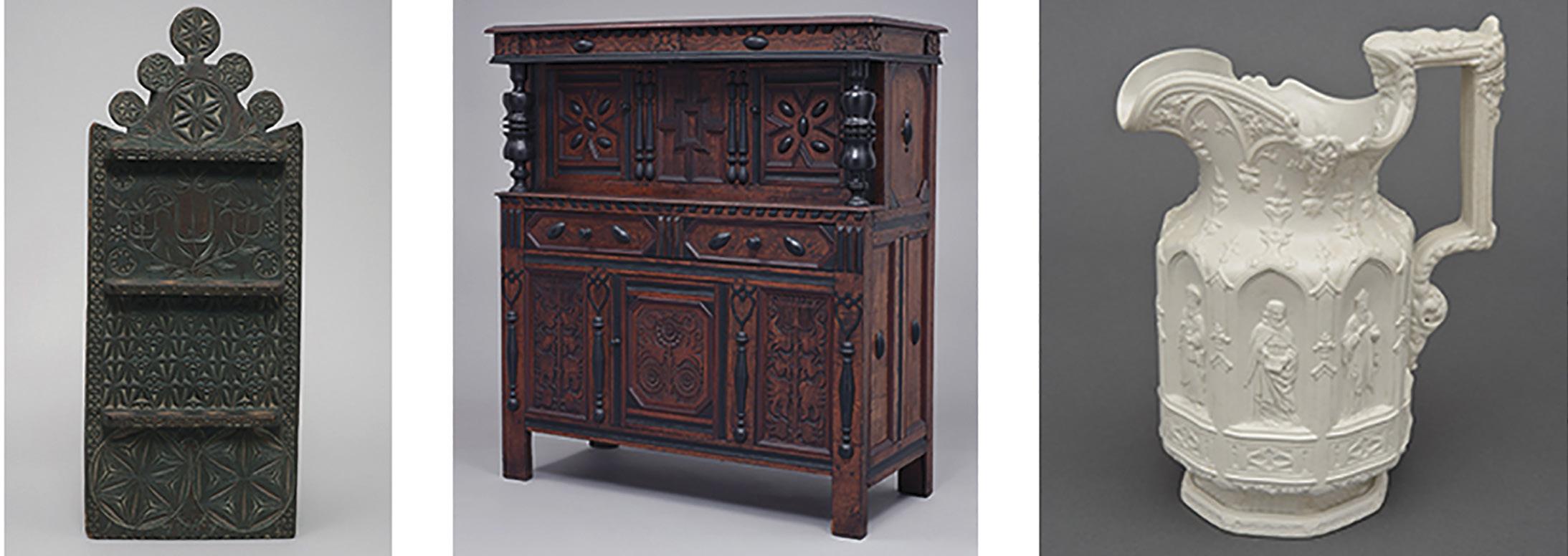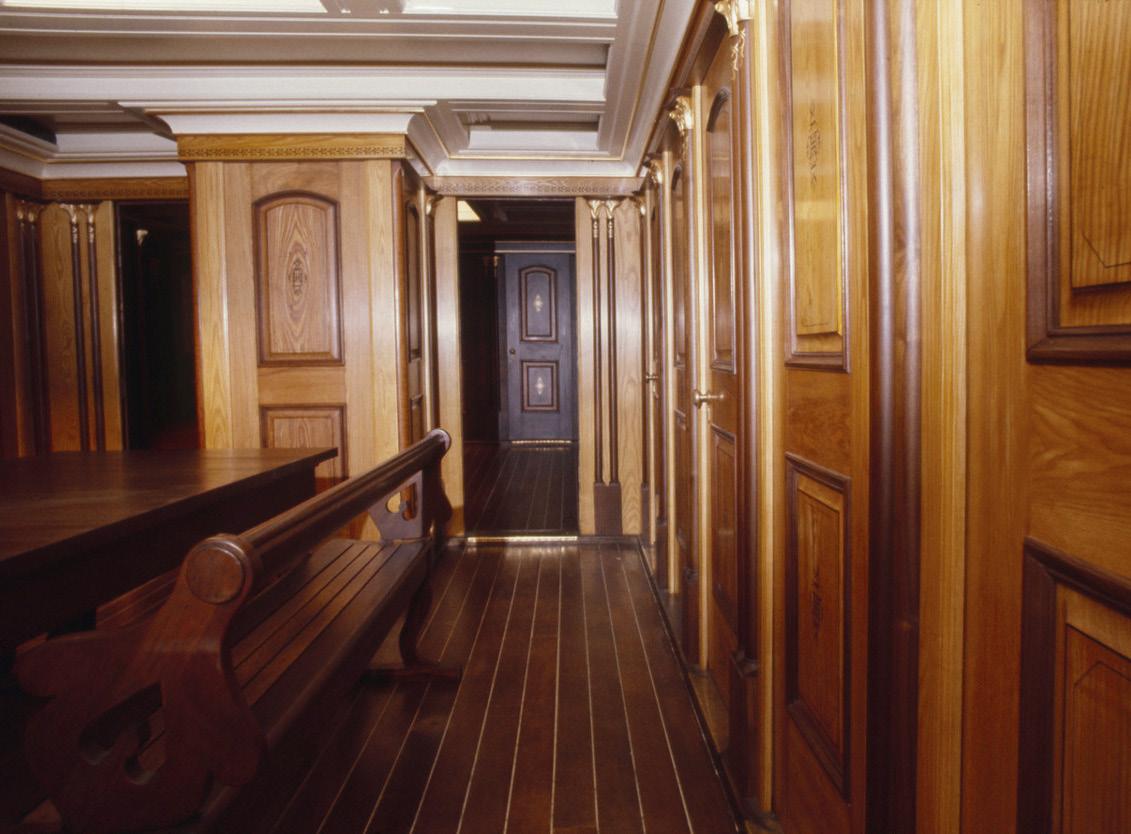
7 minute read
MUSEUM GUIDANCE
RESETTING THE TABLE: Food and Our Changing Tastes
Peabody Museum of Archaeology and Ethnology Through November 2020 Resetting the Table: Food and Our Changing Tastes
Advertisement
One dinner served in 1910 forms the centerpiece—literally— of Resetting the Table: Food and Our Changing Tastes, the new exhibition at Harvard’s Peabody Museum of Archaeology & Ethnology, one of the four Harvard Museums of Science & Culture. Resetting the Table explores food choices and eating habits in the United States, including the sometimes hidden, but always important, ways in which our tables are shaped by cultural, historical, political, and technological influences. peabody.harvard.edu
Museum of Fine Arts, Boston February 9, 2020 Islamic Miniature Painting with Saira Wasim
The MFA’s Arts of Islamic Cultures Gallery is designed to expand how visitors see and understand the diverse arts of Islamic cultures. Its thematic installation—developed through an intensive eight-year process of engagement with Islamic, artistic, and scholarly communities—is divided into distinct spaces that reflect the richness of these artistic traditions. Some sections explore art forms that are integral to all Islamic cultures, like Arabic calligraphy, while others focus on unique visual traditions such as that of Ottoman Turkey or Mughal India. Still, other sections delve deeper into the history of singular objects in the collection, for example, a remarkable door assembled from fragments of medieval Egyptian woodwork for the first American World’s Fair. The MFA’s collection of Islamic art encompasses works from countries of the Middle East, North Africa, and South Asia, as well as works created across the globe within Islamic communities or societies. The collection was established in 1870, the year the MFA was founded, and has grown to become one of the most important in the US. mfa.org Léon Gérôme, and Odilon Redon illustrate the ebb and flow between academic traditions of drawing the body and freer approaches that challenged those conventions. Detailed studies addressing a model’s features and form, and occasionally, movement within their physical surroundings, commingle with intimately scaled sketches that explore gesture and pose with spare lines. Compositions bearing grid lines and handwritten annotations illuminate the relationship between drawing and other media, including painting and printmaking. Many of the drawings reveal the diversity of effects achieved with graphite, the primary instructional medium before mid-century.
This exhibition highlights approximately thirty works from the Diamonds’ remarkable collection of more than 100 French drawings and sculptures, which the couple assembled over the past half-century. Choice figure studies from the Clark’s collection will complement the selection, underscoring the varied uses and functions of figure drawing in 19th-century France. clarkart.edu
The MassArt Art Museum (MAAM) February 22–August 2, 2020 Valkyrie Mumbet
Renowned Portuguese artist Joana Vasconcelos will premiere a new monumental site-specific installation. Known for her unprecedented multimedia works, Vasconcelos, in her first US solo show, will honor Elizabeth “Mumbet” Freeman, an enslaved woman whose court battled for her freedom in 1781 and helped make slavery illegal in Massachusetts. The large-scale installation entitled Valkyrie Mumbet is the newest in her Valkyries series, named after Norse female war goddesses, which pays homage to inspiring women.
The Clark March 21–August 23, 2020 Lines from Life
In celebration of the generous, ongoing gift of Herbert and Carol Diamond, this exhibition explores an array of figure drawings by leading 19th-century French artists. Works by Jean-AugusteDominique Ingres, the Flandrin family, Eugène Delacroix, Edgar Degas, Jean

Experience Lippitt House Ongoing Lippitt House Museum
A National Historic Landmark, Lippitt House, has one of the best-preserved interiors in America, allowing visitors to experience exceptional Victorian design and American craftsmanship. Following the Lippitt family’s example of public service, the Museum’s cultural programming promotes civic engagement, the arts, and the history of Providence. preserveri.org
Haffenreffer Museum Opening February 2020 Assemblages of Migration in the Mediterranean
The Haffenreffer Museum of Anthropology is proud to announce their next exhibit installation, opening February 20, 2020, Transient Matter: Assemblages of Migration in the Mediterranean. Every year, hundreds of thousands of migrants from Syria, Afghanistan, Iraq, Somalia, Congo, and other countries across the Middle East, Africa, and Asia try to cross the Mediterranean Sea, hoping to enter the European Union. These open-water crossings have become the deadliest migratory routes in the world. Since 2014, nearly 1.2 million of these migrants have attempted to reach Europe through the Eastern Mediterranean route, crossing from Turkey to Greece. brown.edu
Newport Art Museum February 8, 2020 - June 14, 2020 Paperwork: Works on Paper from the Permanent Collection
This exhibition showcases a selection of prints and drawings from the Museum’s treasured collection of works on paper. The Newport Art Museum owns over 1200 prints and drawings dating from the 19th-century to the present and includes exemplary works of American art and a small collection of Japanese prints.
Created as studies, sketches, or final works of art, the drawings in the Museum’s collection illustrate the artists’ working processes, as well as the expressive possibilities of materials like graphite, charcoal, ink, and pastel. Crafted as multiples, the prints in the collection reveal the desire of artists to reproduce and disseminate images and messages to a wider audience. From William Trost Richards’ graphite studies of trees to Roy Lichtenstein’s woodcut print of a still life and Pouran Jinchi’s naval signal flag drawings on Colourfix paper, “paperwork” gives visitors a rare glimpse of some of the Museum’s finest works of art. newportartmuseum.org
Museum of Natural History and Cormack Planetarium Ongoing
Rhode Island’s only natural history Museum and home to the state’s only Planetarium make this a great place to visit and thing to do, especially on your next family vacation with children. The Museum offers regular exhibits, events, and attractions. The Planetarium features a state-of-the-art Zeiss star projector and an enlarged domed ceiling on which the stars are projected. Children under age four are not permitted into the Planetarium.
Hours: Museum open daily, 10 a.m.-4 p.m., with the last admission at 3:30 p.m. Museum admission, is $2; Planetarium admission is $3. Information: providenceri.com/museum
syrian coffee pot: gift of herbert de Roth, 1920. © president and fellows of harvard college, peabody museum of archaeology and ethnology.

Connecticut Historical Society and Library Through May 2, 2020 War, Maps, Mystery: Dutch Mapmaker Bernard Romans and the American Revolution
This exhibit will share the little-known story of Revolutionary War Patriot and Dutch mapmaker Bernard Romans. Romans came to the American colonies in 1757 during the French and Indian War, surveying for the British along the Atlantic seaboard. Romans became a supporter of American independence, joined the Continental Army, and eventually settled in Wethersfield, CT. Both the British and Americans used Romans’ maps during the American Revolution. In 1780, he was captured by the British and died in 1784, mysteriously, while a prisoner.
Incredibly rare maps from the CHS collection, published by Romans and his contemporaries, as well as earlier Connecticut maps from the 17th and 18th centuries, will be displayed. With special gratitude to Priscilla Romans Hexter and Madeleine Hexter. The Hexters are direct descendants of Bernard Romans and his first wife, Maria Wendell. Priscilla Hexter has done extensive research on the life of Romans. She identified his birth date of 1741 (not 1720, as claimed in several books and articles) and had his record at the Library of Congress changed. chs.org
Mystic Seaport Museum Ongoing Benjamin F. Packard Cabin
The original 244-foot square-rigged sailing ship, more than twice the length of the Charles W. Morgan and last survivor of her type, was built in 1883 at the shipyard of Goss, Sawyer & Packard in Bath, Maine, and named for one of the builders. She was typical of the superbly designed, finely crafted Down Easters or Cape Horners of the late 19th-century built to carry cargoes around Cape Horn between America’s Atlantic and Pacific ports. The Down Easters replaced the clipper ships as the economic demands called for less speed and more cargo-carrying capacity. During most of her 20-odd years in the Cape Horn trade, she was owned

by Arthur Sewall & Co. of Bath, the largest firm of Cape Horn merchants at the time, and worked out of New York (though her official port of-registry was Bath). For more information, visit mysticseaport.org
Dinosaur State Park Ongoing Come, travel back to the Age of Dinosaurs
We are one of the largest dinosaur track sites in North America. Beneath our geodesic dome, you will find an exceptional display of early Jurassic fossil tracks that were made 200 million years ago. Surrounding our Exhibit Center are more than two miles of nature trails and the Dinosaur State Park Arboretum, containing more than 250 species and cultivars of conifers, as well as katsuras, ginkgoes, magnolias and other living representatives of plant families which appeared in the Age of Dinosaurs.
The trackway in Rocky Hill, CT, has been designated a Registered Natural Landmark by the US Department of Interior. This historic site was preserved for future generations because of the dedication and foresight of many volunteers, educators, and concerned citizens. The Friends of Dinosaur Park and Arboretum, Inc., a non-profit organization, not funded by the state government, exists to promote and ensure the perpetuity of this significant, historical and educational resource and its related exhibits. DinosaurStatePark.org







